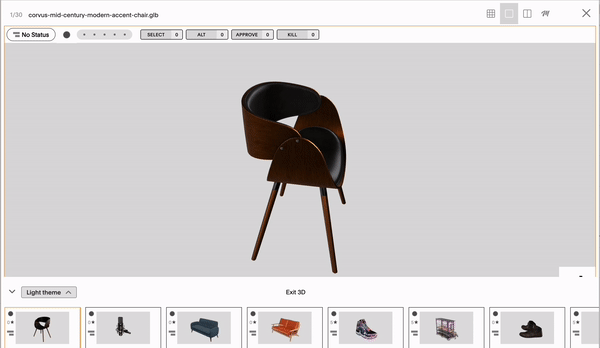AI Smart Tags and 3D Asset Management Come to Globaledit!

Globaledit is excited to unveil two new features that will help our customers enhance the way they produce content and reach consumers.
These enhancements are derived directly from customer feedback and our commitment to staying ahead of industry trends. Today, we are excited to announce Globaledit’s ability to support 3D files (beginning with .OBJ, .GLB, and .STL formats), as well as Smart Tags, AI-based image recognition and tagging, empowering users to manage and organize their visual content more effectively.
Below is a closer look at both features and the technical infrastructure that make them possible.
AI Image Tagging for Object and Scene Recognition
Globaledit is built to enable our customers to work at enterprise scale. The volume of visual content added to the platform each day makes manual tagging and organization a daunting task. In response to this challenge, we are proud to introduce our new AI Smart Tags feature. Our machine learning algorithms can now analyze your images and automatically identify and tag objects and scenes within them, transforming the way you search and retrieve assets. By simply typing a keyword related to an object or scene, our platform will intelligently search through your library and present you with results in milliseconds.
Smart Tags work alongside industry-standard and custom metadata schemas, with search results reflecting both manual metadata entry as well as AI-powered Smart Tags. The tagging system continues to learn and improve over time, ensuring increasingly accurate and personalized results tailored to your specific content library. This means that the more you use Globaledit, the more robust Smart Tags become, saving you valuable time and effort in managing your visual assets.
Smart Tags stems from our partnership with Amazon Web Services, leveraging their advanced Rekognition machine learning technology. Rekognition makes use of a combination of pre-trained data and deep learning techniques to identify and classify various elements within an image, including objects, scenes, activities, landmarks, and dominant colors. These elements are referred to as labels, and each label is assigned a confidence score that quantifies the accuracy of the detection. Labels with the highest confidence scores are tagged to the image, ensuring the highest accuracy in the tagging process.
We have engineered our AI Smart Tags system for scalability and reliability. Leveraging the efficiency of serverless Lambda functions for compute, we process hundreds of thousands of assets per month. Every user-uploaded asset is securely stored in S3 and seamlessly undergoes parallel processing within a Step Functions-defined state machine. This architecture facilitates large-scale processing, ensuring efficient and timely execution of tasks at any scale.

3D Asset Management: Embracing the Future of E-Commerce and Media
The demand for 3D content is increasing exponentially across industries, from gaming and entertainment to e-commerce and advertising. To ensure that our platform remains at the forefront of the industry, we have integrated comprehensive support for 3D files. You can now upload, store, and manage 3D assets alongside your existing 2D content.
The new features functionality allows customers to work with a full 360-degree view of 3D assets, directly in their browser. Globaledit supports files of all sizes, which is particularly important for 3D assets which can be gigabytes. To make it possible to view these files in-browser, Globaledit compresses assets before rendering them, ensuring that 3D assets of all sizes can load as quickly and seamlessly as your 2D asset library.
The heart of our 3D viewer lies in the rendering engine provided by Three.js. This engine utilizes WebGL, a web standard for rendering graphics, to tap into the full potential of a user’s GPU (Graphics Processing Unit). This enables the high-fidelity, real-time rendering of intricate 3D models, delivering a strong visual experience critical for consumer and entertainment industries. This, combined with our React-based web frontend, has allowed us to bridge the gap between desktop applications and browser-based environments, enabling users to access and interact with 3D models effortlessly.
Our platform embraces the industry-standard .OBJ, .GLB, and .STL formats, providing compatibility with a wide range of 3D modeling software. (Let us know what file format your team would like to see supported!) Whether you are working on intricate product designs, architectural models, or immersive virtual reality and augmented reality experiences, our platform delivers a centralized hub to manage and work with your 3D assets. You can preview, organize, and collaborate on these files just as you would with your 2D assets, streamlining your creative workflows and boosting productivity.
Last year, Globaledit rearchitected and relaunched our web-based creative production platform with a scalable modern infrastructure. This groundwork has given our product and engineering teams the ability to rapidly conceptualize and develop new features that meet the evolving needs of our customers. Both 3D Asset Management and AI Smart Tags are an example of our capability to ship features quickly and iteratively.
We encourage you to explore these new features and the impact they can have on your workflows. Your feedback is invaluable to us, and we are dedicated to continuously improving and expanding our platform based on your needs.
